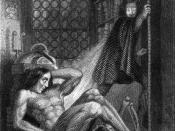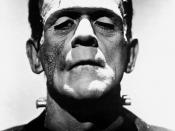Isolation is a common human tendency that society uses to deal with a stressful situation. In the timeless novel "Frankenstein", by Mary Shelly, there is a constant theme of isolation, leading to loss and tragedy. Consequently, this theme becomes exponential as the loss and tragedy lead to more isolation. The cycle continues throughout the story, up to the point where both Victor Frankenstein and his creature die near the North Pole. The creature and Doctor Frankenstein are constantly repulsed by each other keeping their cycle of loss and isolation in motion.
The first presentation of isolation in the novel is that of Victor Frankenstein. In the isolation of the town Ingolstadt he searches for knowledge on the secrets of life. However, Victor only uses the secrets he has uncovered to reanimate a dead body and create a monster. Victor describes his situation, "I had worked hard for nearly two years, for the sole purpose of infusing life into an inanimate body.
I had desired it with an ardour that far exceeded moderation; but now that I had finished, the beauty of the dream vanished, and breathless horror and disgust filled my heart" (Shelly 48-49). Frankenstein has shown the first example of how isolation leads to his tragedy. He stays in his apartment alone, obsessing over creating life, not thinking of consequences of his actions. This traumatic event causes Frankenstein to flee his apartment, leaving his creation alone.
This action however leaves Victor's creature in isolation and confusion. Now the cycle continues and the creature must try to survive on his own, in seclusion. The creature comes across humans, but they only see him as a monster and attack him without any reason besides his appearance. The creature is extremely lonely and confused as he tries to make sense...


